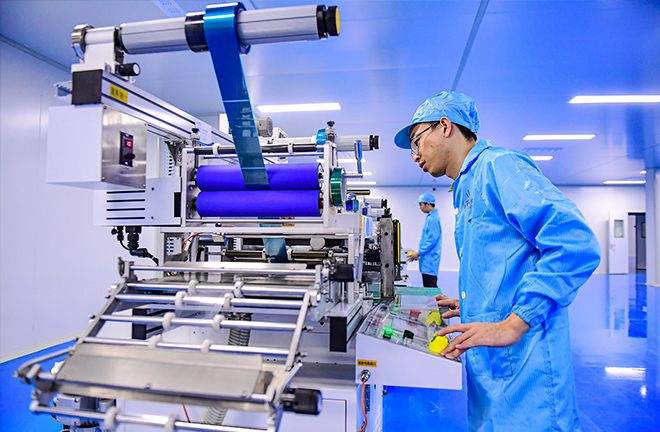Qualitatively new productivity promotes high-quality economic development

A production base for graphene film in Shenyang, Liaoning Province, Aug 31, 2023 Photo: CFP
General Secretary Xi Jinping’s important remarks on qualitatively new productivity have provided fundamental observations for the comprehensive implementation of an innovation-driven development strategy, the fostering of industrial structural optimization, the facilitation of coordinated development of regional economies, the cultivation of new competitive strengths in future industries, and furthermore the advancement of high-quality development of the Chinese economy.
Manifestation forms
Productivity is the most dynamic and revolutionary factor driving social progress. The development of social productivity is an important indicator of social progress and a key force in promoting societal development. In terms of the factor structure of productivity, qualitatively new productivity differs from traditional productivity in that it involves the improvement and enhancement of tangible factors (laborers, means of production, and objects of labor), as well as intangible factors (technology, management, information, and data), with particular emphasis on the leading role of technological innovation in advanced productivity.
The “newness” of qualitatively new productivity is reflected in two aspects: the composition of factors and specific manifestations. The composition of factors is new, including new types of workers who master new technologies, new means of production such as intelligent devices, intangible labor objects such as digital space, as well as new technologies, new management models, and new data factors. Specific new manifestations of innovation rely on advanced productivity in new technologies, industries, forms, and fields.
The “quality” of qualitatively new productivity is characterized by four key elements. Firstly, it represents a new essence, as the model of economic development has shifted from traditional factor driven to innovation driven. Secondly, it emphasizes high quality, as the advancement of Chinese modernization and the construction of a modern socialist country in all respects necessitate that qualitatively new productivity aligns with the goal of high-quality development. Thirdly, it underscores the importance of high quality, as the transformation of the principal social contradiction requires that qualitatively new productivity must better meet the people’s needs for a high-quality life. Fourthly, it leverages the advantage of “quality,” as the new stage of development requires both the “new” and “quality” aspects of qualitatively new productivity to be rooted in technological innovation, break away from traditional growth paths, and form advanced productive forces that meet the demands of the digital economy era while promoting high-quality development.
New impetus
Qualitatively new productivity can empower high-quality economic development through traction effects. Technological innovation plays a leading role in the development of qualitatively new productivity, with science and technology serving as the primary productive forces. Currently, breakthroughs in artificial intelligence, molecular engineering, graphene, virtual reality, quantum information technology, controllable nuclear fusion, clean energy, and other technologies are driving technological revolutions and industrial transformation.
Qualitatively new productivity can empower high-quality economic development through structural effects. The economic growth of modern society has structural effects. Firstly, the economic growth of modern society generally follows the Petty-Clark theorem, with labor gradually shifting from agriculture to more efficient industries and services. Secondly, technological innovation generally appears first in individual departments, and gradually benefits other departments through the diffusion effect of related industries. Thirdly, every country or region tends to have leading and pillar industries within a certain period of time, which serve as the primary driving forces of their economic growth.
Qualitatively new productivity can empower high-quality economic development through multiplier effects. Qualitatively new productivity highlights new technologies, industries, forms, and fields that are sectors and industries characterized by high productivity and added value, thereby facilitating the continuous growth of economic output and the sustained enhancement of development quality through the multiplier effect.
Qualitatively new productivity can empower high-quality economic development through growth effects. The growth effect mainly reflects the changes in the speed of GDP growth. By promoting technological innovation, upgrading industrial structure, improving resource allocation efficiency, and innovating institutional mechanisms, total factor productivity can be continuously improved, thereby unleashing economic growth potential and ensuring sustainable and high-quality economic development.
Key pathways
Firstly, by prioritizing high-tech innovation as the driving force, we aim to expedite the achievement of self-reliance in science and technology. Secondly, we will concentrate on advancing manufacturing and actively fostering strategic emerging industries and future industries. Thirdly, we seek to invigorate enterprise enthusiasm, initiative, and creativity through institutional innovation. Fourthly, we endeavor to propel technological innovation and industrial development with high-quality human resources.
Xie Lu is an associate professor from the Business School at Chengdu University of Technology. Han Wenlong is a professor from the School of Economics at Southwestern University of Finance and Economics.
Edited by ZHAO YUAN
